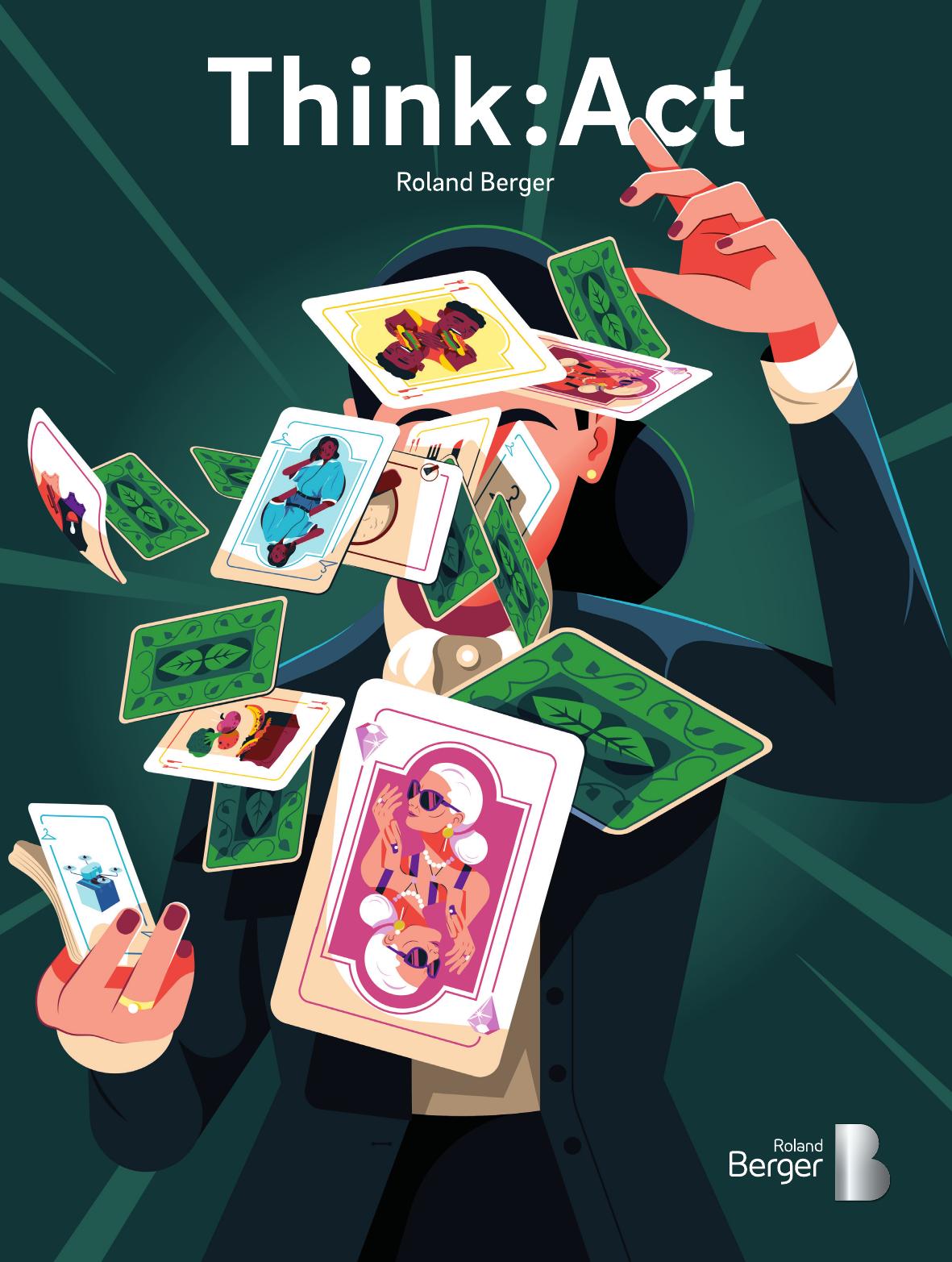HownewrulesarereshufflingconsumergoodsmarketsThesustainabilitygameTHEBIGMoreandmorecountriesaroundtheglobearecommittingthemselvestoandregulationisgoingtoincreasesignificantly.→P.12netzeroOurConsumerPressureIndex,basedonanalysisofconversationsacross14countries,showsthatsustainabilityisnotjustapurchasingcriterionforconsumers–it'sahygienefactor.→P.0884millionKeyconsumergoodsindustriescurrentlyestimatethemarkettobewortharoundinretailsalesglobally–buttosecurefuturegrowth,theymustnowputsustainabilityattheheartoftheirstrategy.→P.05USD14trillionCoverillustration:AntonHallmann/Sepia1–PAGE05Therulesofthegamearechanging.Sustainabilityisamatterofsurvival.2–PAGE08Consumerandregulatorypressureisgrowing.Weprovidetransparency.3–PAGE14Fromfoodandbeveragestoluxury.Deepdivesintokeyconsumergoodsindustriesandtheirsustainabilityefforts.4–PAGE29Solutionsforconsumergoodscompanies.Ourrecommendations.Contents3ThesustainabilitygameThink:ActExecutiveSummaryENVIRONMENTAL,SOCIALANDCORPORATEGOVERNANCEissuesarefrontofmindforexecutivesinalltypesofindustriestoday,andtheconsumergoodsindustryisnoexception.Pressurefromconsumersontheonesideandregulatorsontheotherisreshapingconsumergoodsmarketsandradicallychangingtherulesofthegame.Companiesmustactfastorriskseeingtheirrevenuescollapse–andpotentiallytheirveryexistencecalledintoquestion.Butwitheveryriskcomesopportunity.Researchcarriedoutforthepurposeofthisstudy,includingananalysisofsome84millionpostsonsocialmedia,e-commercesites,forumsandblogsacross14countries,providesuswithuniqueinsightsintowhatisdrivingthechangesinthemarketandhowcompaniescanbest"leverage"them.Thedatacreatesapictureofwhatthesustainableconsumerof2030couldlooklike–theirlifestyle,theirsenseofresponsibility,theirvalues–andhowpressurefromregulatorsdiffersfromcountrytocountryandindustrytoindustry.ThesetwofactorsareencapsulatedinourConsumerPressureIndex(developedincooperationwithourpartnerSymanto)andourRegulatoryPressureIndex.Wealsopresentaseriesofdeepdivesintothefourkeyconsumergoodsindustries:foodandbeverages(F&B),fashion,personalandhomecare,andluxury.Weexaminewherecurrentactiononsustainabilityistakingplace,thechallengesforsustainabilitygoingforward,whatthesurveydatatellsusabouteachindustry,andhowthingsmaychangebytheyear2030.Tosecuretheirfuturesuccess,consumergoodscompaniesmustputsustainabilityrightattheheartoftheirstrategy.Withthisinmind,wepresenteightrecommendations,someapplicabletocompaniesinspecificindustriesandothersacrosstheentiresector.Inparticular,companiesshouldrememberthattacklingthesustainabilitychallengeisnotsomethingthatcanbeputoff.Thetimetoactisnow,whenmarketsarebeingreshuffled,andnottomorrow,whentheymayfindtheyhavebeendealtalosinghand.4Think:ActThesustainabilitygameTOMAINTAINOURSTANDARDOFLIVING,wecurrentlyusetheequivalentof1.75Earthsintermsofresourcesandecologicalservices,accordingto"TheWorldCounts".Ecosystemscannotkeepupwithourdemands.Asaresult,between100and300millionpeopleareatincreasedriskoffloodsandhurricanesandmanymoreareaffectedeachyearbyextremeweatherconditions.Sustainabilityhasbecomemorethanjustabuzzword–itisnowamatterofsurvival.HowarebusinessesreactingtothegrowingconsumerandregulatorypressuretotakeactiononESGissuesandreducetheirenvironmentalimpact?Andwhateffectwillconsumerconcernsandtighteningregulationshaveontheconsumergoodsindustry?Thepressureoncompaniestoactrepresentsasevereriskforbusinessacrossallregionsandindustries.Playersthatfailtoreactwillbepunishedbybothconsumersandinstitutions,andmayevenfaceathreattotheirsurvival.CompaniesaregrapplingwiththechallengeofforecastingtheirCO2emissions,sothattheycanthenmeettheirtargets.Failuretodosocanbecostly,asCO2emissionshavebecomeanewworldwidecurrency.Theprecisenatureoftheriskcompaniesfacedependsontheirindustryandgeography.Butwitheveryrisktherealsocomesopportunity,suchasbeingafirstmoverintheparadigmshiftandenjoyingcompetitiveadvantagesasaresult.Ratherthanjustarisktobusiness,sustainabilitycaninfactbecomeakeydriverofvalue–aswediscussinthisstudy.Beforeweinvestigatetheimpactofsustainabilityonconsumergoodsmarkets,weshouldtakealookatthecurrentshapeoftheindustryandwhatliesaheadofit.AfteraslumpduringtheCOVID-19pandemic,thefourkeyconsumergoodsindustries–foodandbeverages,fashion,personalandhomecare,andluxury–areexpectedtobeworthUSD14trillionin2023.Asawhole,thesefourindustriesareexpectedtoseeaCAGRofaroundsevenpercentthrough2030.AHowever,inWesternmarketstheoutlookisnotaspositive.ThefashionindustryandthepersonalandhomecareindustryareexpectedtoshowCAGRsoffivepercentbetween2022and2025inEuropeandNorthAmerica,andthefoodandbeveragesindustryshouldachieveaCAGRofsixpercent.WithaCAGRofsevenpercent,theluxuryindustryhasthehighestexpectedgrowthforthisperiod.Growthisexpectedtobesimilarorslightlylowerfortheentireperiod2022-30,withthefoodandbeveragesindustryseeingthestrongestCAGRatsixpercent.B1–Therulesofthegamearechanging.Sustainabilityisamatterofsurvival.Companiesthatfailtorespondtothesustaina-bilitychallengewillbepunishedbybothconsumersandinstitutions,andmayevenfaceathreattotheirsurvival.5ThesustainabilitygameThink:ActThesegrowthrates,mainlydrivenbyincreasingpopulationsizesratherthanincreasingconsumption,shouldbeawake-upcallforcompanies.Growthwillslowdownfurther,especiallyinWesterneconomies.Ifplayerswanttocontinuetoexpand,theycannolongerrelyonapositiveunderlyingmomentuminthemarket.Morelikely,wewillseefiercefightingovermarketsharesaseveryonecompetesforthesamepieceofthepie.Inthecontextofthisbattle,companiesoftenoverlooksustainabilityasacrucialfactorinconsumers'purchasedecisions.Sustainabilityishighlyvaluedbyshoppers,andcompanieswithgoodenvironmentalcredentialsincreasinglyenjoyastrongcompetitiveadvantage.Indeed,sustainabilityisoftentheXfactor,thetraitthatmakesacompanystandoutfromthecrowdandthethingthatconvincesshopperstochooseonebrandoveranother.Thisisespeciallytruewherecompaniesbecomemoresustainablebymeansofinnovationandnewbusinessmodelsratherthanthroughactionsthatleadtoaninevitableincreaseinprices.Whenitcomestoactingonsustainability,however,weadvisecaution.Makingashowofcaringaboutsustainabilitywithoutactuallybeingsustainablecanhavedramaticconsequences.Newregulationsarebeingdevelopedtocombat"greenwashing",andconsumers–especiallyGenZ–areparticularlysensitivetoanyhintofdishonestywhenitcomestocompanies'environmentalcommitments.Tosecurecompetitiveadvantages,companiesneedaholisticsustainabilityroadmapthatencompassestheentirevaluechain,fromgrowingandsourcingrawmaterialstotheproductionofproducts,theirsale,andtheiruseanddisposalSource:Euromonitor;Statista;RolandBergerAOutlookforglobalconsumergoodsMARKETSIZEBYINDUSTRY,USDTRILLION,2019-30201911.813.0202214.7202416.9202619.5202822.6203012.5202113.9202315.8202519.0202721.0202911.72020Food&BeveragesFashionPersonal&HomeCare74%74%74%74%73%72%72%72%72%72%74%70%17%17%18%17%18%19%19%19%19%19%18%21%6%6%6%6%6%6%6%6%6%7%6%6%3%3%3%2%3%3%3%3%3%2%2%2%Luxury+7%DataupdatedwithmostrecentdatasetfromStatistaforF&BandEuromonitorfortherest.Numbersmaynotaddupto100%duetorounding.6Think:ActThesustainabilitygameBOutlookforEuropeandNorthAmericaCAGRSIZEBYINDUSTRY,2022-30Source:Euromonitor;Statista;RolandBergerbyconsumers.Businessesmustconsidersustainabilityineachofthesesteps.Thatisachallengingundertaking,especiallyinthecaseofcomplexsupplychains.Inshort,thewayconsumergoodscompaniesdobusinessrequiresamajorrethink.Thecompetitiveparadigmisshiftingandsustainabilityhasbecomeakeyvalue.Businesseswithconventionalapproachesrisklosingmarketshare.Thosethattakenoactionatallriskdisappearingfromthemarketaltogether.Consumersandgovernmentsarestillstrugglingtofindacommonunderstandingofwhatsustainabilityis.Whichprecisecriteriashouldweusetojudgewhetherabusinessmodelissustainableornot?Doesitdependontheoriginoftheingredientsorrawmaterials,say,thecompany'seffortstoreduceemissions,ortheproduct'sextendedlifetime?Isitaboutconsuminglessorreusingmore?Refurbishingexistingproductsordisposingofthemproperly?Whicheverenvironmentalcriteriaultimatelyestablishthemselves,itisclearthatsustainabilitywilldisruptconsumergoodsmarketsinthecomingyears.Indeed,thedisruptionhasalreadybegun,withconsumerawarenessaboutenvironmentalissuesincreasingnoticeablyasaresultoftheCOVID-19pandemic.Thereshapingoftheretaillandscapewillhappenwhethercompanieslikeitornot,andirrespectiveofhowfastorslowindividualbusinessesareinreactingtoit.Itisthereforewellworthtakingasystematiclookatthetwokeydriversofsustainability:pressurefromconsumersandpressurefromregulators.Weturntothisinthefollowingchapter.202220252030FashionIndustry5%5%202220252030LuxuryIndustry5%7%202220252030Personal&HomeCareIndustry5%4%2022202520306%Food&BeveragesIndustry6%7ThesustainabilitygameThink:Act2–Consumerandregulatorypressureisgrowing.Weprovidetransparency.TWOMAINFACTORSarecurrentlydrivingsustainability:pressurefromconsumersandpressurefromgovernments,thelatterexpressedintheformofregulationandtaxation.Thisputsplayersataseverebusinessandcompliancerisk.Now,morethanever,theyneedtransparencyoverconsumergoodsmarketsandhowtheyarebeingreshuffled.Withthisinmind,wehavedevisedtwoindices–aConsumerPressureIndex,indicatinghowstronglyconsumersarepushingforactiononsustainability,andaRegulatoryPressureIndex,indicatinghowmuchpressuregovernmentsarepreparedtoexercisetoachievethesegoals.CONSUMERPRESSUREINDEXWedevelopedtheConsumerPressureIndex(CPI)usingAI-basedsentiment,whichsystematicallyidentifies,extracts,quantifiesandstudiesaffectivestatesandsubjectiveinformationfrompostsonsocialmediaandsimilar.Thisallowsustodetecttheoveralltonalityofanentiretextaswellasparticularattitudestowardsaspecifictopic,givinginsightsintotheimportanceofandattitudestowardsthattopic.Weanalyzedaround84millionconversationsacrossthe14countriesandfourcoreindustriesfor"risk"(percentageofcriticalconsumersdemandingactionfromindustry),"relevance"ofsustainability(percentageofESGtopicswithinindustries)and"willingnesstopay"forsustainableproducts(percentageofconsumerswhomentionpriceandarepositiveaboutit).WecalculatetheCPIforeachindustryineachcountrybyweightingthesethreefactors,with"risk"playingthebiggestrole,weightedat60percent.ByweightingallfourindustryCPIsforonecountrybasedonindustrysize,wecancalculatetheCPIonacountrylevel.OurConsumerPressureIndexisuniqueintermsofbothitsmethodology(seebox)andthedepthofinsightitprovides.Forthefirsttime,itoffersatrulyholisticviewofconsumersentiment(relevance,topics,impactonwillingnesstopay)overallandinspecificindustries.Itisalsouniqueinitsrange,covering14differentcountriesthattogetheraccountfor80percentofthetotalconsumergoodsandretailmarket:theUnitedStates,UnitedKingdom,Netherlands,Germany,France,Italy,Spain,SaudiArabia,UnitedArabEmirates,India,China,Japan,BrazilandMexico.CPILuxuryCPIPersonal&HomeCareCPIFashionCPIF&B60%10%30%ConsumerPressureIndexRisk:%ofcriticalconsumerswhoaredemandingactionfromindustrySustainabilityrelevance:%ofESGtopicswithinindustriesWillingnesstopay:%ofconsumerswhospeakaboutpriceandarepositivetowardsitSource:Symanto;RolandBerger58%34%8%1%OverallcountryCPI8Think:ActThesustainabilitygameINSIGHTSINTOCONSUMERPRESSURE#1Consumerpressureisgreatestinthefashionindustry,personalandhomecareindustryandfoodandbeveragesindustryTheCPIismediumorhighinthefashionindustry,foodandbeveragesindustryandpersonalandhomecareindustryforalmostall14countries.Onlyintheluxuryindustryissignificantlylowerconsumerpressurefound.WheretheCPIishigh,consumersaredemandingincreasedactionfromcompanies,especiallyintheareasofbiodiversityandlanduse,communityrelationsandhumancapitaldevelopment.TheNetherlandshasthehighestoverallCPI,withthehighestCPIinthreeofthefouranalyzedindustries(luxury,fashion,andpersonalandhomecare).OnlyinthefoodandbeveragesindustrywasthehighestCPImeasuredforIndiaforcultural,traditionalandreligiousreasons,andthisindustryhasthestrongestweightingintheoverallCPIcalculation.CPIsarehighestacrossalmostallWesternEuropeancountriesandtheUnitedStatesandlowestinBrazilandJapan.CSource:Symanto;RolandBergerCWesternEuropehasthehighestCPIsCONSUMERPRESSUREINDICESBYCOUNTRYANDINDUSTRYEuropeAmericasMiddleEastAsiaCOUNTRIESINDUSTRIESUKFranceItalySpainNetherlandsGermanyBrazilMexicoUnitedStatesIndiaChinaJapanUAESaudiArabiaF&BFashionPers.&HomeCareLuxuryHigh:CPI>8Low:CPI<6ConsumerPressureIndex:Medium:CP6–89ThesustainabilitygameThink:ActREGULATORYPRESSUREINDEXTheRegulatoryPressureIndex(RPI)aimstodepicttheESG-relatedregulatorypressureoncompaniesfromexistingandupcomingregulations.Theindexconsistsofthreeelements:relevantindicatorsfromtheRolandBergerClimateCombatRadar,theGlobalRiskProfileHumanRightsIndexandanevaluationofESGlegislationinthe13countries.1TheRolandBergerClimateCombatRadarmeasuresthreedimensionsonacountrylevel:attitudetowardsclimatechange,actiononclimatechange,andstatusofmeasurescombatingclimatechange.Forthepurposeofthisstudyweselected14indicatorstoactasaproxyforESG-relatedregulatorypressure,includingclimatepolicy,subsidiesforcleanenergyandmunicipallandfillwastetargets.TheESGIndexrankingbyGlobalRiskProfilecomprisesenvironment,humanrightsandhealthandsafetysubindices.Thismakesitpossibletoassessthird-partyriskstocompaniesduetochangingregulations.WeextracteddatafromtheHumanRightsIndex,whichcovers182countriesandlooksattheratificationstatusof18keyconventions,socialrightsindicators(relatedtoslavery,childlabor,education,housingandsoon),civilandpoliticalrightsindicators(pressfreedom,minorityrightsandsoon)andcollectiverightsindicators(measuresofpeace,righttoself-determinationandsoon).Finally,welookedatthemostimportantlawsandregulationsrelatingtoESGineachcountry,evaluatingthemfortheirrelevanceforthefourconsumergoodsindustries.LegislationincludedtheUK'sExtendedProducerResponsibility(EPR)underwhichproducerswillhavetopaythecostsofmanaginghouseholdpackagingwaste,theUSCleanWaterActregulatingwaterpollution,andJapan'sActonPromotionofFoodLossandWasteReduction,whichdefinesreductionoffoodlossasasocialmeasureforpreventingstill-ediblefoodsfrombeingdiscarded.ForafinalcheckwereferredtosummariesbylawfirmsoftheESGlegislationinthecountriesinquestion.TheRegulatoryPressureIndex(seebox)looksatthesamecountrieswiththeexceptionofMexico.Bothindicesfocusonthefourcoreconsumergoodsandretailindustries,namelyfoodandbeverages,fashion,personalandhomecare,andluxury.Takentogether,theindicesprovideasolidandtransparentbasisforcompaniestoprioritizetheiractionsonESGissuesandreducetheirenvironmentalimpact.#2Sustainabilityisnotjustapurchasingcriterionforconsumersacrossallindustries,it'sahygienefactorSustainabilityisamust.Inthesocialmediaandotherpostsanalyzed,consumersexpressaclearwillingnesstoadapttheirpurchasingbehavior.Manypostsalsoshowclearevidencethattheirauthorsareemotionallyinvolvedinthetopic.Relevance,riskandwillingnesstopaydifferfromindustrytoindustry.Intermsofmedianvalues,sustainabilityappearstobemostrelevantfortheluxuryindustry.Also,consumersappeartobeslightlymorewillingtopayforsustainabilitywhenitcomestofashionandpersonalandhomecaregoodsthantheyareintheareaoffoodandbeverages.#3Somesustainabilityissuesaffectallfourindustries,othersareindustry-specificIntermsofESGtopics,environmentalissuesenjoythehighestlevelofawarenessamongconsumers.Thisispartlyduetorecentenvironmentaldisasters.Thesecondmostprominentareaissocialissues,withgovernanceissuesinthirdplace.TheleadingenvironmentaltopicforconsumersisCO2emissions,withtargetssuchasnetzero,carbonneutralityandtheParisAgreementthemostfrequentlymentionedgoals.Otherhottopicsincludehealth(duetotheCOVID-19pandemic),waste,andvegetarian,veganandorganictopics(forthefoodandbeveragesindustryandpersonalandhomecare).Intermsofindustry-specifictopics,consumersspeakmostaboutregulationwhendiscussingthefoodandbeverages,fashion,andpersonalandhomecareindustries.Theyalmostnevermentionregulationwhentalkingabouttheluxuryindustry.Also,whileenvironmentaltopicsarethemostimportantsubjectsinthefoodandbeveragesindustryandthepersonalandhomecareindustry,socialtopicsaccountformorethan50percentofconversationsinthefashionandluxuryindustries.Intermsofgeographicalfocus,environmentaltopicsaremostcommoninEurope,theMiddleEastandAsia,whilesocialtopicspredominateintheAmericas.Amongtheenvironmentalsubtopics,thecommonestsubjectsareresourcesandanimalrights.Themostrelevantsocialsubtopicisdiversityandinclusion,followedbycommunityrelations.Governanceistheleastcommontopicinallindustriesandcountries.Withingovernance,management-relatedissuesarethemostrelevantsubtopic,followedbylegalviolationsandbusinessethics.10Think:ActThesustainabilitygame#3Increasingregulatorypressureraisesprices,assustainableproductsaremoreexpensivetoproduceThecostsofproducingsustainableproductsaregenerallyhigher,especiallyincountrieswithlow-costproductionregulationsrequiringmoresustainability,whichcanhaveasignificantcostimpact.Consumersareonlysometimeswillingtoabsorbthesecostincreases,whichcanpresentcompanieswithachallenge.Thus,consideringtheincreasingregulatorypressuretobecomesustainable,thisleavesmanufacturerswithtwooptions:Theycaneitherinnovateandmakesustainabilityaffordable,ortheycankeeptheirmarginsstableandputuptheirprices.Customersappeartobedemandingtheformeroption–thatcompaniesfosterinnovationintheareaofsustainability.Ouranalysisrevealsthatconsumersarewillingtopayforsustainableproducts,buttheirwillingnesstopayextraisinsufficienttocovertheincreasedproductioncosts.Companiesthereforeneedtoconsiderwhattheadditionalcostsofsustainabilityareandhowmanycustomerstheywouldlosebyraisingtheirpricessufficientlytofullycovertheseadditionalcosts,andatthesametime,pursueinnovationwhereverpossibleintheareaofsustainability.Wherepriceincreasestoimprovesustainabilityareunavoidable,itiscrucialthatcustomersaremadeawareofthis.Atpresent,consumersdonotalwaysunderstandthereasonforpricepremiums.Greatertransparencyandharmonizedorganicstandardsarethereforenecessaryinordertofurtherboosttheirwillingnesstopay.Thisiscrucialasthegloballyincreasingregulatorypressurewillleavecompanieswithnochoicebuttobecomemoresustainable,andifpotentialcostincreasescannotbeabsorbedthroughinnovationorbythecustomers,thatcanposeaseriousbusinessrisk.INSIGHTSINTOREGULATORYPRESSURE#1RegulatorypressureisstrongerinWesterncountriesWesterncountriesandJapanfacethegreatestregulatorypressure.InEurope,EUrulesdominate,whilesomeEUcountrieshaveadditionallegislationthatgoesevenfurther,suchastheGermanSupplyChainDueDiligenceAct.Japan'sgovernmentiscommittedtoclosingthegaptoEUlegislation.InNorthAmerica,NGOsplayastrongerrole.ArabandAsiancountriescurrentlyhavelowregulatorypressure,butthisisexpectedtoincreaseovertime.InChinaandIndia,pressurecanbeexpectedtogrowinresponsetoextremelyhighlevelsofurbanairpollution.Overall,moreandmorecountriesarecommittingthemselvestonetzero.Inlinewithincreasedpressurefromregulators,taxationonnon-sustainableproductsislikelytoincrease.Moreover,non-sustainablecompanieswillfinditincreasinglydifficulttosecurecreditfinancing–aseriousbusinessriskthatfirmscannotaffordtoignore.D#2Regulationismostrelevantinthepersonalandhomecareindustries,followedbyfoodandbeverages,luxuryand,finally,fashionCountriesintheEuropeanUnionhavethehighesttotalnumberofrelevantlawsacrossallfourindustries,andGermanyhasthehighesttotalnumberofallcountries.Indiaalsohasalargenumberofrelevantlaws,especiallywithregardtosocialtopics.SaudiArabiahasthesmallestnumberofrelevantlawsacrossallfourindustries.ECompaniesneedtobeawarethatnotbeingsustainablemaybeaseriousbusinessriskinthefutureduetoincreasingglobalregulatorypressure.11ThesustainabilitygameThink:ActDWesterncountriesandJapanhavethehighestRPIsREGULATORYPRESSUREINDICESBYCOUNTRYEEUcountrieshavethemostregulation,acrossallfourindustriesRELEVANCEOFLAWSANDREGULATIONSBYCOUNTRYANDINDUSTRYSource:RolandBergerEuropeAmericasMiddleEastAsiaCOUNTRIESINDUSTRIESUKFranceItalySpainNetherlandsGermanyBrazilUnitedStatesIndiaChinaJapanUAESaudiArabiaF&BFashionPers.&HomeCareLuxuryHigh:Relevance>4Low:Relevance<3Relevanceoflawsandregulations:Medium:Relevance>3–<4Source:RolandBergerHigh:RPI>4Low:RPI<3RegulatoryPressureIndex:Medium:RPI>3–<4EuropeAmericasMiddleEastAsiaCOUNTRIESUKFranceItalySpainNetherlandsGermanyBrazilUnitedStatesIndiaChinaJapanUAESaudiArabiaGraphicDshowsthecountries'RPIvalues,consistingofthreeelements(ClimateChangeCombatRadar,HumanRightsIndexandLaws&Regulations).GraphicEshowsthevaluesforthedifferentcountriesfortheLaws&Regulationselementonly.Thus,whileacountrymayperformwellinLaws&Regulations,thisdoesnotnecessarilyleadtoagoodoverallperformanceintheRPIitselfsincetheaverageofthethreeelementsistakentodeterminetheRPI.12Think:ActThesustainabilitygameSUSTAINABILITYASALIFESTYLEThesustainableconsumersofthefuturewillseesustainabilityandhealthascorelifevalues.Inaddition,theywillcareabouttheworldandhaveaglobalperspective.Asaresultofthat,theywillbesustainabilityambassadorsandthoughtfulconsumers.AWARENESSOFINDIVIDUALRESPONSIBILITYSustainableconsumersmonitortheirownsustainabilityperformanceandhaveapresenceonsocialmedia.Theyusetheirplatformtoholdcompaniesaccountableandrejectanyfalseclaimsofsustainability(greenwashing).Additionally,theyengageinconsumeractiontoadvocatefornewregulationsthatpromotesustainability.BUYLESS,DOITYOURSELF/SECONDHANDThesustainableconsumersofthefutureprioritizeenvironmentallyfriendlydeliveryoptions,prefersecondhandgoods,makepurchasesbasedonneedsratherthandesires,andhaveapreferenceforsecondhandorrepaireditems.Moreover,theyarealsowell-informedabouttheingredientsandmaterialsusedintheproductstheybuy.AGLIMPSEINTOTHEFUTURE:WHATTHESUSTAINABLECONSUMEROF2030MIGHTLOOKLIKESUSTAINABILITYASTHENO.1PURCHASEFACTORTheconsumersofthefutureprioritizesustainabilityandarewillingtopayextraforenvironmentallyfriendlyproducts.Theydemandtransparencyaboutaproduct'ssupplychain,seekoutbrandsthatalignwiththeirpersonalvalues,andonlyremainloyaltobrandsthatmeettheirexpectations.Inaddition,sustainabilityisexpected,andconsumerspreferlong-lastingproductsthataredurable.DIGITALSAVVYTheconsumersofthefutureadapteasilytonewtechnologies(internetofthesenses)andworkandsocializevirtually.Furthermore,technologyisusedtotakeinformedsustainabilitydecisions.Illustration:AntonHallmann/Sepia13ThesustainabilitygameThink:Act3–Fromfoodandbeveragestoluxury.Deepdivesintokeyconsumergoodsindustriesandtheirsustainabilityefforts.FoodandbeveragesThefoodandbeveragesindustry–oneoftheoldestindustriesintheworld–ishighlyfragmented.In2019thetoptencompetitorsmadeupeightpercentofthetotalmarket.2TheUnitedNationspredictsthatfoodproductionwillhavetoincreasebyasmuchas70percentbetween2010and2050inordertomeettheneedsofagrowingglobalpopulation.In2022themarketreachedavalueofUSD9,354billion,anditisexpectedtogrowtoUSD16,815billionin2030–aCAGRofaroundsixpercent.AThecountriesinthisstudyaccountforaround60percentofthetotalglobalmarket.ChinaandtheUnitedStatesmakeup45percentoftheglobalmarket,followedbyIndia.ChinaandBrazilenjoythehighestgrowthrates.WithinEurope,GermanyandFrancearethelargestmarkets.CURRENTACTIONONSUSTAINABILITYFoodandbeveragescompaniesarecurrentlyfocusingonreducingtheirenvironmentalimpact,minimizingwasteandensuringsustainablesourcing.Theindustryaccountsfor36percentofglobalemissions,mainlystemmingfromfarmingandharvesting(39.2percent),landuse(31.4percent)andwaste(8.8percent).3Meatemissionsaccountforalmost57percentoftotalemissionsrelatedtofoodproduction,withbeefhavingthebiggestcarbonfootprint.Theimpactonothercategoriesisalsostrong:Forexample,agricultureaccountsforaround70percentofallfreshwaterwithdrawalsworldwide.Foodproductionoccupiesapproximately40percentoflandaroundtheglobe.Itisthebiggestfactorthreateningspecieswithextinction,itcauseseutrophication(nutrientoverload)anddeadzonesinlakesandcoastalareas,andithasalreadyledtoamajorityoftheworld'sfishstocksbeingfullyfishedoroverfished.InanefforttoreduceCO2emissions,especiallyfrommeatproduction,companiesareofferingmoreandmorehealthyanddiet-specificitems.Theyincludegluten-free,veganfoods,plant-basedproteinsandfoodproductswithfewerchemicalsandpreservatives.Everyyear,roughlyone-thirdoffoodproducedforhumanconsumption–around1.3billiontons–islostorwasted.TheUnitedNationsestimates4thateighttotenpercentofglobalgreenhousegasemissionsareassociatedwithfoodthatisnotconsumed.Foodpackagingalsomakesupthelargestshareoflitterinalmostallaquaticenvironments.Intermsofsustainablesourcing,thecurrenttrendistowardsmoreorganicandlocallygrownandraisedproducts.TheglobalorganicfoodandbeveragesindustryisexpectedtogrowwithaCAGRof14.4percent5between2020and2027.Transparent,ethicalsupplychainsarealsobecomingmoreimportant,withincreasingnumbersofmanufacturersjoininginitiativessuchasFairtrade,theRainforestAllianceandUTZ.Roomforimprovementremains,however:Currently,56percent6ofcompanieshavenoScope3emissionreductiontargets,despitethefactthatScope3emissionsmakeup90percent7oflifecycleemissions,andjusteightpercent8ofcompanieshavefullhumanrightsduediligencemechanismsinplace.14Think:ActThesustainabilitygameSUSTAINABILITYCHALLENGESThechallengeswithregardtosustainabilityencompasstheindustry'senvironmentalimpact,fromcomplexsupplychainstopackagingwaste.9Forexample,itisdifficultforplayerstoachievefulltransparencyoverfoodoriginsandprocessstepsduetothehighlycomplexsupplychains.Inaddition,factorssuchaspandemics,drought,cropfailure,warandtransportationcrisesindicatethattheindustrylacksresilience.10Climatechangehasadirectimpactonagriculture,witheveryonedegreeincreaseinglobalmeantemperaturepotentiallyloweringwheatyieldsbyuptosixpercent,riceyieldsbyupto3.2percent,maizeby7.4percentandsoybeansby3.1percent.11Itisbecomingincreasinglychallengingtofeedagrowinghumanpopulationandatthesametimelowertheenvironmentalimpact.Wasteisaproblemparticularlywhereconsumersrefusetobuyfoodthatnolongerlooksitsbestorisapproachingits"bestbefore"date.12Consumersalsooftenbuymorefoodthantheyneed.Foodwasteisaparticularlychallengingtopicasconsumerawarenessislackingonthistopic.Manyplaces,especiallydevelopingcountries,alsolackstronginfrastructureformanagingpackagingwaste.MorethanhalfoftheplasticlitterintheoceanscomesfromChina,Indonesia,thePhilippines,ThailandandVietnam.13Intheareaofsustainablefoodsourcing,itisworthnotingthatbiologicallydiversifiedfarmsrequiremorediverseandappropriatelyscaledequipment,whichcanonlybeusedatcertaintimesoftheyearorforspecificcrops.14Thesefarmsalsoneedtomakeupfrontinvestmentsinsoilhealthandecosystemfunctioning,whichmayonlypayforthemselvesafteranumberofyears.Currentconcernsoffarmersregardingtheimplementationofsustainablefarmingpracticesincludeanxietyaboutfinances,laborchallenges,lackofconfidenceinnewapproachesortheirownabilitytomanagethetransition,anduncertaintiesregardingcollaborationwithsupportinginstitutionssuchasbanks.KEYFINDINGSOurinvestigationfoundthatculturalbackgroundhasahugeimpactontheperceivedrisksandrelevanceofsustainabilityinthefoodandbeveragesindustry.Forexample,IndiahasthehighestoverallCPIandseesthehighestriskintheareaofanimalrights.InGermany,theperceivedriskofclimatechangeandemissionsisapproximatelythesameasforanimalrightsandresources.AndinSpaintheperceivedriskishighestforhumanrights,andthenresources.Consumerawarenessismuchhigherforenvironmentaltopicsthanforsocialorgovernancetopicsintheindustry.Thus,52percentofpostsonsocialmediaandsuchlikeconcernenvironmentaltopics,comparedto36percentonsocialtopicsandjust12percentongovernance.Willingnesstopayisalsobyfarthehighestforenvironmentalconcerns.Wefoundthatmacroeconomiceventshaveabigimpactonconsumers'perceptionofriskandtherelevanceofdifferenttopics.Forexample,Russia'swarinUkrainehaspromptedconsumerstocallformoreregulationonthepriceoffoodanddrinks.Similarly,thetopicoffooddonationsandcharityhasbecomemorerelevantsinceCOVID-19andthewarinUkraine.FFDevelopmentoftop5ESGtopicsinthefoodandbeveragesindustryPERCENTAGEOFALLPOSTSABOUTESGONSOCIALMEDIAANDSUCHLIKE,2020-22Source:Symanto;RolandBerger14%12%10%8%6%4%2%0%OrganicFoodDonations&CharityVegetarian&VeganEco-FriendlyRegulation20202021202215ThesustainabilitygameThink:ActMATERIALSPRODUCTIONTRANS-PORTATIONPOINTOFSALECUSTOMERSIllustration:AntonHallmann/SepiaTHEFOODANDBEVERAGESINDUSTRYOFTHEFUTURE:ASUSTAINABLEVISIONFOR2030ANDBEYOND16Think:ActThesustainabilitygameIntheareaofMATERIALS,neweco-friendlyandplant-basedsourceswillbeused,suchasinnovativeformsofproteins.Foodwithengravedmarkingsratherthanplasticpackagingorstickerswilltakeovertheshelves.Specialattentionwillbeplacedoncompostableandrecycledpackaging,withsustainablepackagingbecomingstandard–forexample,"combined"packaging,wherethelidandbaseareconnected,forready-to-eatproducts.IntheareaofPRODUCTIONwewillsee"localforlocal"–localproductionforlocalcustomers–alongsideimprovementsinhowanimalsaretreatedandanincreaseinorganicproducts,veganitemsandlab-grownmeat.Therewillbegreaterfocusonbiodiversity,sustainablefarming,sustainableagricultureandurbanfarming.TRANSPORTATIONwillbereorganizedtosaveonCO2emissions,withe-trucksfueledby100-percentgreenenergybecomingstandard.Traceabilitywillbecomehighlyimportantforpurchasedecisions,witheachingredienttraceablealongacompletelytransparentsupplychain.AtthePOINTOFSALE,aglobaldepositschemeandtaxonPETwillmakepackagingwastemoresustainableandreduceplasticpackagingingeneral.Retailerssuchassupermarketswillhavecuratedsustainabilityassortments,andproductsandmanufacturerswhodonotofferproductsmeetingcertainsustainabilitystandardswilldisappearfromsomedistributionchannels.In-storeefficiencieswillincrease,forinstancebypartneringwithfoodsurplusapps,andproductswillbelabeledwithESGtags.Supermarketsandotherretailerswillofferlockersforpick-updeliveriesForCUSTOMERS,on-demanddelivery,forinstanceviadeliverybots,willbecomemoreimportant.Customerswillhavetheoptiontodonateanamountofmoneytooffsetemissions.Thetrendtowardshealthyfoodswillincrease,withdata-drivenpersonalizedfoodsandcigarette-likelabelingforunhealthyfoods.Manufacturersandretailerswillalsoworkwithlocalcharitiestosupportvulnerablegroups,andfoodwillbe"upcycled"–forexample,restaurantswillcreatedishesusinglow-valuefoodssuchasblackbeansandbarleytoreducefoodwaste.FashionThefashionandtextileindustrycomprisesapparel,footwearandpersonalaccessories.Ithasthesecondhighestemissionsintheworld,with15-30percentoftheplasticpollutionintheoceanscausedbymachinewashingofclotheswithsyntheticfibers.15Furthermore,85percentofgarmentsthrownawayendupinlandfills,and20percentofwaterpollutioniscausedbytextileproduction.16Aftershrinkingduringthepandemic,thefashionmarketreturnedtoroughlyits2019levelin2022,atUSD2,445billion,andisforecasttogrowtoaroundUSD3,856billionby2030–aCAGRofaroundfivepercent.AThecountriesinthisstudyaccountforaround73percentoftheglobalmarket,withtheUnitedStatesandChinaaccountingfor45percentoftheglobalmarketvalue,followedbyIndia.InEurope,GermanyandtheUnitedKingdomarethelargestmarkets.CURRENTACTIONONSUSTAINABILITYManyfashioncompaniesacknowledgethenegativeimpactoftheindustryontheenvironmentandhavecommittedthemselvestotargetssuchasnetzero,orsigneduptopledgessuchastheFashionIndustryCharterforClimateAction.Forinstance,inChina–theworld'slargesttextileproductionandexportingcountry–industryassociationslaunched"actionroadmaps"aimedatenhancingsustainabilityin2019and2021.Fastfashionhasespeciallyledtoa"democratization"ofstylishclothingandincreasedtheavailabilityofnewstylessignificantly.Butthishasadownsidefortheenvironment:Theaverageconsumertodaybuys60percentmoreclothingthanin2000,andlessthanonepercentofusedclothingisrecycledintonewgarments.17Consumersneedtobeeducatedabouttheenvironmentalimpactoftheirpurchasinghabitssothattheycanmakemoreresponsiblechoices.Atthesametime,consumerpressureoncompaniestotakeactionishighacrossallcountries,asshownbyouranalysisofCPIs.GRespondingtoconsumerpressureonthetopicofsustainabilityhasbecomeamajorissueforfashionandtextilecompanies.Butthereisaproblem:Iftheycommunicatetoomuch,theyriskaccusationsofgreenwashing,whileiftheycommunicatetoolittle,consumersmaythinkthattheydon'tcare.18Somefashioncompanieshavetakenonleadingrolesassustainabilitypioneers.Forinstance,in2009PatagoniaandWalmartfoundedtheSustainableApparelCoalition(SAC),aglobalWEFORESEEANUMBEROFDEVELOPMENTSINTHEFOODANDBEVERAGESINDUSTRYINTHEPERIODTO2030.17ThesustainabilitygameThink:Actmulti-stakeholdernonprofitallianceaimingtopromotesustainabilityinthefashionindustry.SUSTAINABILITYCHALLENGESManynewbrandshaveemergedinrecentyearsthatplaceastrongemphasisontheirenvironmentalcredentials,includingsustainabilityinitiativesandenvironmentalcertifications.19However,shortproductlifecyclesrequirefashioncompaniestodevelopandproducenewproductsatafastrate.Itwouldbegreatifeco-friendlyproductionmethodsandtechnologiesweredevelopedatthesamepace.Moreover,noindustry-wideunderstandingexistsatpresentofwhatconstitutesasustainableproductormaterials.20Nonetheless,thereisalotofwisdominthemarket.Adisconnectremainsbetweenconsumerawarenessandbehavior.Abigproportionofthefashionconsumersarecostsensitive,whichchallengesfashioncompaniestoproducewithlowerpollution,CO2emissionsordisposallevels,andtoinvestinmaterials,improvingworkingconditionsorwaterusage.21Theindustryneedstoinnovatetomakesustainableproductsaffordable.ArecentstudybyaGermanonlinefashionretailerfoundthat60percentofconsumersclaimtransparencyisimportanttothem,butonly20percentactivelyseekoutinformationduringthepurchasingprocess.22Thisdisconnectisalsoseenintheresultsfromouranalysis,whereconsumerwillingnesstopayformanysustainabilitytopicsinthefashionindustryislowerthantheperceivedriskandrelevanceofthosetopics.Ashifttowardsmoresocialsupplychainsrequiresmassivechanges,encompassinginternalprocesses,supplychainorganization,cultureandmindsets.23Evenwheremanufacturersofferadequateworkingconditions,thisisnotnecessarilythecasefortheirsubcontractors.24Ingeneral,itiscrucialthatworkersindevelopingcountriesdirectlybenefitfromimprovingworkingconditionsinthefashionindustryandthelocalcommunityaswell.Theconcentrationofwomeninthissectorisrelativelyhigh,andtextileproductionplaysaroleinreducingpovertyamongwomenbutcandoevenmore.25Fashioncompaniesneedtonarrowtheirfocusonsustainability,prioritizingcertaintopicsoverothers.Thiswillenablethemtoachieverealimprovementsratherthansuperficialones.Communicatingthisprioritizationrequiressolidargumentstoprotectagainstnegativepublicityandreputationaldamage.Atthesametime,companiesmustactquicklyasgovernmentsareincreasinglytighteningupregulationsandstrengtheningenvironmentaltaxationregimes.Formingcross-brandalliancestolearnandshareaswellasinvestinconsumereducationandnewtechnologiesisthewayforward.KEYFINDINGSOuranalysisrevealsthatcompaniesintheEuropeanUnionfaceagreaternumberofregulationsthancompaniesoutsidetheEuropeanUnion,andthattheseregulationsareoftenstricterthanelsewhere.Forexample,France'sExtendedProducerResponsibilityregulationmeansthatproducersorimportersmusttakephysicalorfinancialresponsibilityfortheentirelifecycleofthetextilestheybringintocirculation,includingdisposalandrecycling.InChina,bycontrast,regulationshaveonlyanindirectimpactonthesustainabilityofthefashionindustry.Amajorconcernofconsumersinthefashionindustrycentersonsocialtopics.Thus,amajorityofconversationsaboutsocialaspects(54percent)relatetosocialsustainability,withaparticularemphasisondiversityandinclusion(17percent),donationsandcharity(13percent)andhumanrights(tenpercent).Consumersrecognizethepowerofthefashionindustrytodefinebeautystandardsandthereforedemandrealistic,accuraterepresentations.However,anincreasingnumberofconsumersareawareof"diversitywashing"–brandstryingtoprofitfromsocialcauseswhilenotactivelycontributingtothetopic.26Consumersexhibitgreaterwillingnesstopayforenvironmentalcausesthanforsocialcauses.Thegreatestwillingnesstopayisintheareaofresources(75percent),disposal(59percent)andanimalrights(56percent).HOuranalysisfurtherrevealsthatconsumers,especiallyinWesterncountries,areawareofthenegativeenvironmentalimpactofthefashionindustry.Almostone-thirdofpostsonsocialmediaandsuchlikeaboutESGinthefashionindustrywereonenvironmentaltopics,withresources,energy,disposalandclimatechangeandemissionsattheforefront.Consumersalsoexhibitthegreatestwillingnesstopayforthesetopics.Theindustryhasrespondedwithinitiativessuchas"CottonConnect","Fairtradecotton"and"BetterCottonInitiative",aswellasseparateproductlinesfeaturingorganiccottonandrecycledfibers.27Butthisisnotenoughbyfar.Finally,theindustryshouldthinksustainabilityallthewaytotheend.Forinstance,ifpieceslastlonger,aregettingrepairedorbeingboughtsecondhand,howdoesthisimpactthefirsthandmarket?Andwhatimpactdoesithaveonthebusinessmodeloffashionplayersifcircularityorno-wastebecomesthenorm?18Think:ActThesustainabilitygameSource:Symanto;RolandBergerGPressuretoactfromcustomersishighacrossallcountriesFASHIONINDUSTRYCPISBYCOUNTRYHConsumersaremorewillingtopayforenvironmentalthanforsocialcausesWILLINGNESSTOPAYINTHEFASHIONINDUSTRYBYTOPICSource:Symanto;RolandBergerResources75%Disposal50%ChemicalFree47%Diversity&Inclusion44%BusinessEthics59%ClimateChange&Emissions48%Donations&Charity46%HumanRights42%AnimalRightsHigh:WTP>50%EnvironmentalSocialGovernanceLow:WTP<25%Medium:WTP25%–50%56%Eco-system47%Energy45%Manage-ment41%CommunityRelations30%PackagingLegalStandardsLaborStandards30%18%17%China9.0ItalyGermany7.6UK7.0SaudiArabia8.7France7.9Japan7.4US6.9Nether-landsHigh:CPI>8Low:CPI<6Medium:CPI6–88.0Spain7.8Mexico7.1Brazil6.7UAE6.46.8India5.419ThesustainabilitygameThink:ActIllustration:AntonHallmann/SepiaMATERIALSPRODUCTIONTRANS-PORTATIONPOINTOFSALECONSUMERSRECYCLINGTHEFASHIONINDUSTRYOFTHEFUTURE:ASUSTAINABLEVISIONFOR2030ANDBEYOND20Think:ActThesustainabilitygameWEFORESEEANUMBEROFDEVELOPMENTSTAKINGPLACEINTHEFASHIONANDTEXTILEINDUSTRYBYTHEYEAR2030.Eco-friendlyMATERIALS(naturalfibers,organiccotton,recycledpolyester)andnext-generationmaterials(bio-materials,suchasbacteria-basedandmycelium-basedmaterials)willbeusedasafirststepintheproductionprocess.EverysinglestepofthegarmentlifecyclewillbecometransparentthankstoDigitalProductPassports,makingitpossibletotracklaborstandardsinthePRODUCTIONprocess.EmissionandwastestandardswillbeincludedaspartofwiderESGregulation.Internationallawsandstandardsprotectinggarmentworkers'laborrightswillbeestablished,mostlikelyby2030.Overtime,automationwillreplacehardmanualwork,allowingfornearshoringandtheminimizingofTRANSPORTATIONemissions.WhenitcomestothePOINTOFSALE,marketingcampaignswillincreasinglyfocusontopicsrelatedtosustainabilityanddiversityandpromotein-storerepairservices,increasingthelongevityofgarments.In-storewastewillbereducedthroughthereuseofinstallations,eco-packaging,recycledhangersandpaperbags.Productswilldisplayahumanandlaborrightsscore,reducingleftoversandthereforeloweringproduction,whichwillbemuchmoreagile,reactive&demanddriven,inturnloweringthefirsthandmarketproductionvolumes.ForfutureCONSUMERS,theenvironmentalandsocialimpactofgarmentswillbeacriticaldecisioncriterion,withevergreendesignsreplacingfastfashion.Productutilizationandlifetimewillbeincreasedthroughactiveparticipationincircularitypracticesandgreaterpenetrationofdurableapparelproducts.Digitalavatarswillenablecustomerstotryoutgarmentswhenshoppingonline,leadingtofewerreturns.Thefashionseasons(rhythms)willbereadjustedtotherealdemand.Inaddition,storeswillfeatureRECYCLINGcounters,makingrecyclingaccessibletoallcustomers,whilefashionbrands'websitesandservicehotlineswillprovideguidesfordo-it-yourselfrepairsandeco-friendlywashing.Moreover,toincreasefiber-to-fiberrecycling,fashioncompaniesmaybeforcedtousesinglematerialsratherthancompositeones.Theclosedloopwillexistandwillberealizedviaacross-industryR&Dinvestmentprogram.PersonalandhomecareThepersonalandhomecareindustryisamajorsourceofgreenhousegasemissionsandfacessignificantsustainabilityissuesinareassuchasformulations,packagingandlogistics.In2022theindustryreachedavalueofUSD832billion,anditisexpectedtogrowtoUSD1,355billionby2030–aCAGRofapproximatelyfourpercent.AThecountriesinthisstudyaccountforaroundtwo-thirdsoftheglobalmarket.TheUnitedStatesandChinamakeuparoundone-thirdofthetotalglobalmarket,followedbyJapan,withChinaandBrazilenjoyingthehighestgrowthrates.WithinEurope,GermanyandtheUnitedKingdomarethelargestmarkets.28CURRENTACTIONONSUSTAINABILITYSustainabilityissuesaboundinthepersonalandhomecareindustry.Somepartsoftheindustryusequestionableingredients,suchaspalmoil,whichisassociatedwithdeforestation,orengageinanimaltesting(althoughthebiggestuserofpalmoilis,infact,thefoodindustry).29Personalcareandcosmeticproductsareaprimarysourceofmicroplastics.30Packagingisalsomostlymadeofplastic,whichiscreatedfromfossilfuelsandisamajorsourceofplasticwaste.Consumptionisalsoanissue,asamajorshareoftheemissionsassociatedwiththeindustryresultswhentheproductsarebeingused–forexample,thehotwaterintheshowerwhenusingshampoo.31Thecurrentfocusoftheindustryisonswitchingtorefillableandenvironmentallyfriendlypackaging,reducingtheuseofmicroplasticsandcuttingemissions.32Changehereismainlydrivenbyconsumerpressure:CPIsacrosscountriesarecomparativelyhigh.33ISustainabilityinthebeautyandpersonalcareindustryisincreasingoverall,andeffortsinthisdirectionarealsovisibleinthehomecareindustry.34Thus,almostallthetop100personalandhomecarecompanieshavemadepubliccommitmentstodrivingsustainabilityoverthecomingyears.Consumerpreferencesarealsodevelopinginthedirectionofplant-basedformulationsandlesspackaging.Thisisreflectedinouranalysis:Packagingaccountsforthelargestshareofpostsonsocialmediaandsuchlike,at21percent.Willingnesstopayisalsoveryhigh,atover60percentforvegetarian,veganorreusableproducts.3521ThesustainabilitygameThink:ActSUSTAINABILITYCHALLENGESThemainchallengeforthepersonalandhomecareindustryishowtomeetconsumerneedsandexpectations,whileatthesametimedrivingsustainability.36Consumerswantcompaniestoaddressenvironmentalissuesbutareoftenunwillingtocompromiseonconvenienceandquality.Forexample,ourresearchfoundthat"relevance"ofsustainabilitywashighinIndia(scoring10)but"willingnesstopay"muchlower(5.2).Similarly,inJapan"risk"scoredveryhighbutwillingnesstopayverylow(3.6).AnadditionalchallengeforindustryplayersismeasuringsustainabilityKPIsandScope1-3emissionsalongthevaluechain,especiallyatproductlevel.Personalandhomecarecompanieshaveoutsourcedcertainstepsinthevaluechain,suchaspackaging.Theythereforedependontheirsupplierstocomeupwithsustainablesolutions.Evenwheresuppliersfindsuchsolutions,obstaclesremainsuchasthepricingdifferencebetweensustainableandnon-sustainableoptionsandcommercial-scaleavailabilityoftheoptionschosen.37Some60globalleadersinpersonalcareandcosmetics,includingthelikesofL'Oréal,P&GandUnilever,haveestablishedtheEcoBeautyScoreConsortium.Itsobjectiveistodevelopandagreeonanindustrystandard,consistingofaharmonizedapproach,includingrules,scoringmodelandasuitabletoolformeasuringthesustainabilityimpactofproducts.38Thiswillthenbecommunicatedtoconsumersonthepackaging,allowingthemmakemoreinformeddecisions.DiscussionsarebasedaroundtheProductEnvironmentalFootprint(PEF)developedbytheEuropeanCommissionforotherproductcategories,whichrequiresmanufacturerstoanalyze16impactcategoriesor"sustainabilityindicators",includingsomearisingduringtheconsumerusephase–asignificantchallengeformanufacturers.KEYFINDINGSResources,packaginganddisposalintheindustryarethekeytopicsofconversationonsocialmediaandsuchlike.Thewidespreaduseofsingle-usepackagingputsaheavyburdenontheenvironment,creatingpackagingwasteinoceansandlandfills.Thisphenomenonreceiveswidespreadmediaattention,whichisinturndrivingchange.Largeamountsofpackagingcannotberecycledinexistingrecyclingsystems,especiallyinthecaseofmulti-materialpackaging.Recyclingratesforplasticpackagingarealsorelativelylow,comparedtopaperboardandmetalandglass."Willingnesstopay"fortopicsrelatingtoresourcesisrelativelyhigh(83percent),asitisfordisposal(56percent).However,itisbelowaverageforpackaging(31percent).JSource:Symanto;RolandBergerIPressuretoactfromcustomersishighacrossallcountriesPERSONALANDHOMECAREINDUSTRYCPISBYCOUNTRYHigh:CPI>8Low:CPI<6Medium:CPI6–8China9.4Italy7.4Germany7.1UK6.9SaudiArabia8.0France7.1Japan7.0US6.8Nether-lands7.7Spain7.1Mexico7.0Brazil6.1UAE5.6India5.522Think:ActThesustainabilitygameSource:Symanto;RolandBergerJConsumersarewillingtopayforresourcesanddisposalWILLINGNESSTOPAYINTHEPERSONALANDHOMECAREINDUSTRYBYTOPICOntheregulationside,governmentshavestartedtorespondtothepublicoutcry.Regulatorsaroundtheworldarebanningorlimitingtheimportofpackagingwaste,introducingbillsforplasticpackagingorissuingpackagingdesignregulations.39Ouranalysisalsoshowsthatregulationisanincreasinglyimportanttopicforconsumers,havinggrownfromfeaturingin10.3percentofallESGconversationsin2020to13.2percentin2022.Thismakesitnowthetoptopicofconversation.KItislikelythatmicroplasticswillbetotallyexcludedfromproductformulationsinthefuture.LeadingpersonalandhomecarecompaniessuchasHenkelhavealreadybannedmicroplasticsfromtheirproducts,whilebodiessuchasthePersonalCareProductsCouncil–theleadingUStradeassociation–directlyaddressthisissue.TheEuropeanGreenDeal,thenewCircularEconomyActionPlan(CEAP)andtheEUPlasticsStrategyalsoallincludemeasurestacklingpollutionfrommicroplastics.Trulysustainablepersonalandhomecarecompaniesarebecomingincreasinglyattractive,leadingtoariseinmergersandacquisitionsintheindustry.Asconsumersingrowingnumbersdemandsustainableproducts,brandsintheindustrythatdirectlyaddressissuessuchasplasticpackagingareincreasinglyattractiveastakeovertargets.KDevelopmentoftop5ESGtopicsinthepersonalandhomecareindustryPERCENTAGEOFALLPOSTSABOUTESGONSOCIALMEDIAANDSUCHLIKE,2020-22Source:Symanto;RolandBerger14%12%10%8%6%4%2%0%Organic(Resources)PlasticandEcopackaging(Packaging)Eco-Friendliness(Resources)Diversity(CommunityRelations)Regulation(Management)202020212022Resources83%Disposal56%ChemicalFree47%Diversity&Inclusion43%BusinessEthics63%ClimateChange&Emissions50%Donations&Charity44%HumanRights41%AnimalRights61%Eco-system50%Energy43%Manage-ment40%CommunityRelations39%PackagingLegalStandardsLaborStandards31%31%21%High:WTP>50%EnvironmentalSocialGovernanceLow:WTP<25%Medium:WTP25%–50%23ThesustainabilitygameThink:ActIllustration:AntonHallmann/SepiaMATERIALSANDSOURCINGFORMULAANDPACKAGINGTRANS-PORTATIONPOINTOFSALERECYCLINGTOWARDSAMORESUSTAINABLEPERSONALANDHOMECAREINDUSTRY:AVISIONFOR2030ANDBEYOND24Think:ActThesustainabilitygameWEFORESEEANUMBEROFDEVELOPMENTSINTHEPERSONALANDHOMECAREINDUSTRYTAKINGPLACEBY2030.InMATERIALSANDSOURCING,companieswillcomeupwithnewformulationsthatsignificantlyimproveenvironmentalfriendliness,forinstanceallowingconsumerstowashitemsincoldwaterwithoutlossofwashingquality.Animaltestingwillstop,andnewconcentrateswillemergethatrequirelesspackagingorforwhicheco-friendlypackagingcanbeused.IntheareaofFORMULAANDPACKAGING,companieswillincreasinglyswitchtoorganicproductsthatcontainfewerchemicals,nomicroplasticsandresponsiblysourcedpalmoilandpalmkerneloil.Packagingwillbecomerecyclableandwillactuallyberecycled–althoughinpracticelargepartsofpackagingwillbecomeobsoletethankstorefillingsolutions.Beautybrandsinparticularwillusezerowasteandwaterlessclaimsintheiradvertising.Consumerswillenjoytransparencyaboutingredients,theiroriginandemissions.TRANSPORTATIONwillbecomeasemissionlessaspossible,usinge-trucksfueledwith100-percentgreenenergyanddrawingonotherleverssuchasrouteoptimizationandmodeoftransport(rail,road,air).SustainabilitywilllikewisedominatethePOINTOFSALE,withdigitalpricelabelsreplacingpaperlabels.Productswillfeatureinformationabouthowtousethemeconomicallyandecologically,pluscertificationdetailsforsuppliersandfactories.IntheareaofRECYCLING,refundingschemeswillbecomeevenmoreimportantandscrapcollectionandrecyclingprogramswillbeexpanded.LuxuryTheluxuryindustry–comprisingluxuryfashionandhardluxury–iswellpositionedtomoveintothesustainabilityspaceasitsproductsaredurablebynatureandselectivematerialandcraftsmanshipliesatthecore.Notonlythat,butthereisalsoacultureofpassingitemsdownthroughgenerations.However,theproduction,transportation,useanddisposalofluxurygoodsisstillresponsibleforCO2emissionsorenvironmentalandsocialharm.In2022themarketsizewasaroundUSD330billion,anditisforecasttogrowtoUSD576billionby2030–aCAGRofroughlyfivepercent.Thecountriesinthisstudyaccountforsome78percentoftheglobalmarket.ATheUnitedStatesandChinamakeup38percentoftheglobalmarket,followedbyJapan.Brazil,ChinaandSaudiArabiaenjoythestrongestgrowthrates.WithinEurope,France,theUnitedKingdomandItalyarethethreebiggestmarkets.CURRENTACTIONONSUSTAINABILITYEventhoughluxuryfashionproductsareoftenmadeofhigh-qualitymaterials,processingthesematerialsstillgeneratesCO2andreleaseschemicalsintotheenvironment.Infact,high-qualitymaterialsarenotnecessarilymoresustainablethanlow-qualitymaterials:Leathergoods,forinstance,requireintensivecattleranching,whichisknownforhighemissionsandoftenlowanimalwelfare.SomeleadingplayerssuchasLVMHandKeringarecurrentlyincreasingtheireffortstosourceleathersustainablyandinvestingincompaniesproducinghigh-qualityartificial(or"vegan")leather.40Metalminingisparticularlyharmfultotheenvironment,requiringlarge-scalelandclearanceandenergy-intensiveextractionprocesses.Metaloreminingusuallytakesplaceinremotelocations,leadingtohighlevelsoftransportationpollution.41Ouranalysisshowsthatthisisatopicthatconcernsconsumers:ConsumersintheNetherlands,GermanyandSaudiArabiaseeresourcesasthebiggestriskwithintheluxuryindustry.Metalrecyclingisbecomingincreasinglypopular.42Goldminingisalsoassociatedwithseveralenvironmentalchallenges,rangingfromdeforestationtopollution,especiallyofwater.Agrowingnumberofluxuryfashioncompaniesaremakingeffortstobecomemoresustainable,forexamplebycommittingthemselvestonetzero.43TheindustryissubjecttoparticularpressurefrommillennialsandGenZ,whoaredriving85percentofgloballuxurysalesgrowthandarevery25ThesustainabilitygameThink:Actconcernedabouttheenvironmentalandsocialimpactoftheirpurchases.44Theshareofsustainableproductsindepartmentstoresalesisexpectedtorisesignificantlyinthenextfiveyears.Consequently,departmentstoresmaystopbuyingluxurybrandsthatarenotsustainable.Manydepartmentstoresarealreadypromotingsustainabilityusingdedicatedcorners,temporaryshop-windowdisplaysordirectvisualstrategies.Theyareintegratingitintheirbusinessmodel.Changesarealsounderwayinthejewelrysector.Forexample,radicalsupplychaintransparencyorsyntheticstonesnowmakeuptenpercentofthediamondmarket(2022),comparedtojusttwopercentin2018.ApositivedevelopmentforESG,butbynomeansthesolution.Source:Symanto;RolandBergerLWillingnesstopayforsustainableluxuryvariessignificantlyWILLINGNESSTOPAYBYCOUNTRYChinaItalyGermanyUKSaudiArabiaFranceJapanUSNether-landsHigh:WTP>8Low:WTP<6Medium:WTP6–8SpainMexicoBrazilUAEIndia10.05.24.83.99.45.04.43.36.65.04.22.82.61.826Think:ActThesustainabilitygameInourvisionfortheyear2030,theluxuryindustrywillusemoresustainablerawMATERIALSsuchasveganleatheroptions,artificialsilk,"animal-friendly"silkandartificialdiamonds.Theoriginsofproductsandrawmaterialswillbetraceablewiththehelpoftechnologies.Brandswillofferon-demandorcustomizedPRODUCTION,reducingwasteandCO2emissionswhileupholdingscarcity.Productionwillbetakenascloseaspossibletotheconsumer.WepredictthatTRANSPORTATIONandRECYCLINGwillbecomeanimportantpartofthevaluechain,providingconsumerswithfulltransparencythroughtheuseofRFID(radio-frequencyidentification)orothersystems.Transportationwillbemainlybyseaorroad,ratherthanair.AtthePOINTOFSALE,companieswilloffercustomizationsuchas3Dprintsand"batchsizeone".DedicatedESGpersonnelatstorelevelwillaccompanycustomersalongtheirbuyingjourney.Digitalsamplesanddigitaltrackingoftheproductionandsupplychainwillbeavailableatthepointofsale.Adigitalproductpasswillbecomeastandardfeature,aswilldifferentcircularitybusinessmodels.CUSTOMERSwillhavetheoptiontodonatetosocialinitiativeswhenmakingluxurypurchases.Ingeneral,luxurywillbecomemoresustainableandcompanieswillcreatetheirownawardsprograms–Rolex,forexample,alreadyoffersalargecashprizetoentrepreneursorprojectsbringingaboutpositiveenvironmentalorculturalchange,knownastheRolexAwardforEnterprise.Furthermore,CIRCULARITYwillhavedisruptedtraditionalbusinessmodelsandwillmakeupasignificantproportionofsalesandservices.WEFORESEEANUMBEROFTRENDSINTHELUXURYINDUSTRYTHATARESETTOACCELERATEINTHEPERIODTO2030.SUSTAINABILITYCHALLENGESLuxurygoodscompaniesstrugglewithsustainability,oftenduetothecraftsmanshipandthecomplexityoftheirsupplychains.Luxuryproductsdependonuniqueness,andthisisfrequentlyachievedbyusingexclusivenaturalmaterialssuchaswool,cashmereorsnakeskin.Thisoftenthreatensbiodiversity.Althoughluxuryfashionitemsusuallyhavegreaterlongevitythanfastfashionitems,itisquestionablewhetherluxuryconsumersconsumelessinfact,especiallyconsideringthatluxurybrandsareoftenlaunchingnewcollections.Inaddition,manyluxurycompaniesarescepticalaboutengagingincircularity,arguingthatreusinggarmentsorstonesfrompreviouscollectionscoulddilutetheheritageofaluxurybrand.Somecompaniesevenburnentirecollectionsattheendofaseasontopreventthembeingsoldwithdiscountsandharmingbrandequity.KEYFINDINGSOuranalysisrevealsthatluxurybrandsarefacingsocialpressurefromincreasinglyawareconsumers–however,sizeabledifferencesexistbetweencountries.Luxuryhasthehighestscoreforrelevanceofsustainabilityofthefourindustriesexamined,butthedifferencesbetweencountriesrangefromaCPIof8.8intheNetherlandstoaCPIofjust2.5intheUnitedArabEmiratesandJapan.TheCOVID-19crisisfurtherstimulatedtheindustry-widesustainabletransformation,withlargeluxuryconglomeratesnowbeginningtoaddresssustainabilityconcerns,forexample,bypublishingsustainabilityprofitandlossesreportsorbecomingpartofthe"FashionPact".45Pre-ownedluxuryproductsaregrowinginimportance.TheglobalmarketforappareliscurrentlyworthanestimatedUSD141billionandisforecasttogrowsignificantlyinthecomingyearsandtoreachavalueofUSD218billionin2026.46IntheUnitedStates69percentofluxuryshoppersalreadybuypre-owneditems.47Sustainabilitywillbecomeacompetitiveadvantageforluxurybrands,withagrowingnumberofconsumersbeingabletopayapremiumforsustainableproducts.However,willingnesstopayvariessignificantlyfromcountrytocountry:ChinaandSaudiArabiahaveaveryhighwillingnesstopayforlong-lastingluxuryproducts,forinstance,whileIndiahasanextremelylowwillingness.Ifproductpricesacrosscountriesriseowingtosustainablefeatures,consumerswillneedtomaketheirchoice,buttheluxuryindustryshouldbeabletopushESGtopicssignificantly.L27ThesustainabilitygameThink:ActIllustration:AntonHallmann/SepiaMATERIALSCIRCULARITYPRODUCTIONTRANS-PORTATION&RECYCLINGPOINTOFSALECUSTOMERSTOWARDSAMORESUSTAINABLELUXURYINDUSTRY:AVISIONFOR2030ANDBEYOND28Think:ActThesustainabilitygame4–Solutionsforconsumergoodsplayers.Ourrecommendations.Tosecuretheirfuturesuccess,consumergoodsplayersmustintegratesustainabilityguidelinesintotheiroverallcompanystrategy.Inparticular,theyshouldconsiderthefollowingeightkeyfindingsfromouranalysis:#1Companiescangainastrongcompetitiveadvantagebysystematicallypursuingsustainabilitystrategies.ThatmeansconsideringallESGdimensions,implementingactionsacrosstheentirevaluechainandavoidinggreenwashingatallcosts.Reducingecologicalfootprintswillbeespeciallykey,astherapidincreaseoftaxationandregulationwillotherwiseputprofitsatrisk.Inaddition,itisalsocrucialthatcompaniesadjusttheirstrategiestotherequirementsoftherespectivecountries,asthesecandiffernotably.#2Inthefoodandbeveragesindustry,companiescanbenefitfromemphasizingenvironmentalinitiativesoversocialandgovernancetopics,asenvironmentaltopicshavegreaterrelevanceforconsumers.#3Fashioncompaniesneedtoreflecttheircustomers'concernaboutESGtopicsintheirstrategy.Insomecases,theymayleveragetheirconsumers'highwillingnesstopayforenvironmentalcausesbycreatingsustainableproductsandserviceswithahigherpricepoint.Overall,theindustrywillbeconfrontedwithmuchstrongerregulation.Theimplementationofnewtechnologiesandmaterials,aswellasno-wasteinitiativeswillthereforebecomeimperative.#4Personalandhomecarebusinesseswouldbewelladvisedtorespondtoconsumers'demandsforsustainableresourceutilizationandgreendisposalconcepts.Inparticular,sustainablebrandsshouldbantheuseofmicroplasticsintheirproductformulations.29ThesustainabilitygameThink:Act#5Luxurybrandsarefacingpressure,especiallyfrommillennialsandGenZ.Asthesecustomersdrive85percentofgrowthintheindustry,companiesneedtoreact.Inasimilarvein,circularitywillstronglydisruptexistingbusinessmodelsandforcebrandstoreworksupplychains.#6Inallindustries,consumersshowincreasedwillingnesstopayforsustainableproductsandservices.However,theseproductsandservicesneedtoremainaffordableforconsumers,andinthecaseofapricepremium,thereasoningbehindithastobetransparentlycommunicated.Otherwise,demandwillevaporate,counteractingthepositiveeffect.#7Manysustainabilityinvestmentspayoffinthelongrun.Tomeasuretheirsuccess,companiesneedtoconsiderotherperspectives,suchasthefirm'sattractivenessforemployeesandESG-driveninvestors.Investinginsustainabilitycanalsohelpthemreachyoungertargetgroupswiththeirproducts,therebyhelpingthemsavetheirbusinessfromthethreatofextinction.#8Insomecases,consumersarepreparedtorefrainentirelyfrompurchasingnon-sustainableproducts,especiallythosethattheyfeeltheydonotneed.Thiswillputtheentirefirsthandmarketunderpressure,posingasignificantrevenueriskforcompanies.Consumergoodscompanieshavemanyreasonstoinitiatesustainableactivities,suchasaddingvalueforthebrand,companyoremployees,reducingthecostsassociatedwiththeirenvironmentalimpactormakingthemselvesmoreattractivetopotentialinvestors.Inordertomakefact-basedinvestmentdecisions,theywillneedtoquantifytheupsidepotentialoftheseopportunities.Tacklingthesustainabilitychallengecallsforaholisticapproach,involvingfirstbuildingafoundation,thendevelopingasustainabilitystrategy,defininginitiativesandlighthouseprojects,andfinallyimplementingsustainabilitygovernance.Aspressurefromconsumersandregulatorscontinuestogrowandconsumergoodsmarketsarereshuffled,beingsustainableisnolongeranicetohave,itisamust.BeingsustainableandconservingtheEarth'senvironmentmustbeourchiefpriority–thereisnoPlanetB.30Think:ActThesustainabilitygame1�ItwasnotpossibletocollectdataforMexicoaspartoftheRegulatoryPressureIndex.2�UnitedNations(2013):Worldmustsustainablyproduce70percentmorefoodbymid-century–UNreport.https://news.un.org/en/story/2013/12/4569123�Coolset(2022):Theimpactofclimatechangeonthefoodandbeverageindustry.https://www.coolset.com/academy/the-impact-of-climate-change-on-the-food-and-beverage-industry4�UNEP(2022):Stopfoodlossandwaste.https://www.unep.org/thinkeatsave/get-informed/worldwide-food-waste5�Businesswire(2021):GlobalOrganicFoodandBeverageMarketAnalysis&ForecastReport2021-2027.https://www.businesswire.com/news/home/20211116005787/en/Global-Organic-Food-and-Beverage-Market-Analysis-Forecast-Report-2021-2027-Featuring-General-Mills-ConAgra-Brand-Hain-Celestial-Cargill---Precognize(2021):TheKeyFactorsDrivingandHamperingF&BSustainability.https://www.precog.co/blog/sustainability-food-and-beverage-manufacturing/6�CDP(2019):FastMovingConsumers.https://cdn.cdp.net/cdp-production/cms/reports/documents/000/004/150/original/CDP_Consumer_Goods_2019_Exec_summary.pdf?15518916547�Foodprocessing.com(2021):FoodindustrysupplierstakenoteofScope3emissionsfocus.https://www.foodprocess-ing.com.au/content/sustainability/article/food-industry-suppliers-take-note-of-scope-3-emissions-focus1318656999#:~:text=Many%20food%20manufacturers%20are%20now,an%20average%20packaged%20food%20company.8�WorldBenchmarkingAlliance(2021):Thefoodbusinessisfailingpeople.https://www.worldbenchmarkingalliance.org/publication/food-agriculture/findings/the-food-business-is-failing-people/9��EngieImpact(2023):Food&Beverage.https://www.engieimpact.com/industries/food-beverage-sustainabilityFoodprocessing.com(2021):FoodindustrysupplierstakenoteofScope3emissionsfocus.https://www.foodprocessing.com.au/content/sustainability/article/food-industry-suppliers-take-note-of-scope-3-emissions-focus-1318656999#:~:text=Many%20food%20manufacturers%20are%20now,an%20average%20packaged%20food%20company.10�Precognize(2021):TheKeyFactorsDrivingandHamperingF&BSustainability.https://www.precog.co/blog/sustainability-food-and-beverage-manufacturing/11�ZhaoChuangetal.(2017):Temperatureincreasereducesglobalyieldsofmajorcropsinfourindependentestimates.https://www.pnas.org/doi/10.1073/pnas.170176211412�Chinie,CatalinaAlexandra(2020):Challengesforreducingfoodwaste.https://www.researchgate.net/publication/343703546_Challenges_for_reducing_food_waste13�OceanConservancy(2022):StemmingtheTideStatementofAccountability.https://oceanconservancy.org/wp-content/uploads/2017/04/full-report-stemming-the.pdf14�Carlisle,Lizetal.(2019):TransitioningtoSustainableAgricultureRequiresGrowingandSustaininganEcologicallySkilledWorkforce.https://www.frontiersin.org/articles/10.3389/fsufs.2019.00096/full15��TheWorldBank(2019):HowMuchDoOurWardrobesCosttotheEnvironment?https://www.worldbank.org/en/news/feature/2019/09/23/costo-moda-medio-ambiente#:~:text=The%20fashion%20industry%20is%20responsible,more%20than%2050%20%25%20by%202030.16�Ibid.17�Ibid.Tableofsources31ThesustainabilitygameThink:Act26�FashionsFinest(2021):Theimportanceofbodypositivityinthefashionindustry.https://www.fashionsfinest.com/news/item/5974-the-importance-of-body-positivity-in-the-fashion-industry27�Karaosman,Hakanetal.(2020):Behindtherunway:Extendingsustainabilityinluxuryfashionsupplychains.https://www.sciencedirect.com/science/article/pii/S0148296318304673?via%3DihubCOData(2023):CottonandSustainableCotton:KeyWorldCommodity.https://www.commonobjective.co/article/cotton-and-sustainable-cotton-key-world-commodity#:~:-text=Better%20Cotton%20Initiative%20(BCI),-The%20Better%20Cotton&text=Based%20on%20six%20principles%2C%20the,for%20farmers%20and%20their%20workers.28�CDP(2019):TopFMCGsinracetokeepupwithconsciousconsumers.https://www.cdp.net/en/articles/media/top-fmcgs-in-race-to-keep-up-with-conscious-consumersPlanetMark(2023):FutureofFMCG.https://www.planet-mark.com/future-of-fmcg/29�PETA(2023):Thesebeautybrandsarestilltestedonanimals.https://www.peta.org/living/personal-care-fashion/beauty-brands-that-you-thought-were-cruelty-free-but-arent/30�Bashir,SaiduM.etal.(2021):PersonalCareandCosmeticProductsasaPotentialSourceofEnvironmentalContamina-tionbyMicroplasticsinaDenselyPopulatedAsianCity.https://www.frontiersin.org/articles/10.3389/fmars.2021.683482/full31�PlasticPollutionCoalition(2022):TheUglySideofBeauty:TheCosmeticsIndustry’sPlasticPackagingProblem.https://www.plasticpollutioncoalition.org/blog/the-cosmetics-industrys-plastic-packaging-problem18�Forbes(2021):FashionIndustry:AvoidingCommunicationLandmines.https://www.forbes.com/sites/forbesbusiness-council/2021/07/13/sustainability-in-the-fashion-industry-avoiding-communication-landmines/?sh=1d93099961a619�SourcingJournal(2020):What’sHoldingUpSustainableChangeforFashionPlayers?https://sourcingjournal.com/topics/thought-leadership/apparel-fashion-supply-chain-sustainability-roit-kathiala-197314/20�Ibid.21�EuropeanParliamentBriefing(2020):TextileworkersindevelopingcountriesandtheEuropeanfashionindustry–Towardssustainability?https://www.europarl.europa.eu/RegData/etudes/BRIE/2020/652025/EPRS_BRI(2020)652025_EN.pdf22�Forbes(2021):FashionIndustry:AvoidingCommunicationLandmines.https://www.forbes.com/sites/forbesbusiness-council/2021/07/13/sustainability-in-the-fashion-industry-avoiding-communication-landmines/?sh=1d93099961a6Zalando(2021):Attitude-BehaviorGapReport.https://corporate.zalando.com/en/attitude-behavior-gap-report#consumer-attitudes-seven-key-themes23�SourcingJournal(2020):What’sHoldingUpSustainableChangeforFashionPlayers?https://sourcingjournal.com/topics/thought-leadership/apparel-fashion-supply-chain-sustainability-roit-kathiala-197314/24�EuropeanParliamentBriefing(2020):TextileworkersindevelopingcountriesandtheEuropeanfashionindustryTowardssustainability?https://www.europarl.europa.eu/RegData/etudes/BRIE/2020/652025/EPRS_BRI(2020)652025_EN.pdf25�TheWorldBank(2012):SewingSuccess?Employment,Wages,andPovertyfollowingtheEndoftheMulti-fibreArrangement.https://documents1.worldbank.org/curated/en/488191468330919867/pdf/Sewing-success-employ-ment-wages-and-poverty-following-the-end-of-the-multi-fibre-arrangement.pdf32Think:ActThesustainabilitygame40��Kering:SustainabilityProgressReport(2020-2023):https://progress-report.kering.com/home/discover-care/care/BellevueNZZ(2022):PelzundLederausdemLabor:DiegrösstenLuxuskonzerneinvestierenindieForschung.https://bellevue.nzz.ch/mode-beauty/lvmh-und-kering-investieren-in-leder-und-pelz-aus-dem-labor-ld.168259841�SwissWatchMagazine(2021):SustainabilityintheSwissWatchIndustry:Part1–MiningandMaterials.https://swisswatches-magazine.com/blog/sustainability-in-the-swiss-watch-industry-part-1-mining-and-materials/42�Ibid.43�Forbes(2021):IsSustainabilityTheNextFrontierForLuxuryBrands?https://www.forbes.com/sites/forbesagencycouncil/2021/11/24/is-sustainability-the-next-frontier-for-luxury-brands/?sh=74c7dbd096b544�LuxeDigital(2023):SustainableLuxury:MillennialsBuyIntoSociallyConsciousBrands.https://luxe.digital/business/digital-luxury-trends/millennials-buy-sustainable-luxury/45�Forbes(2021):IsSustainabilityTheNextFrontierForLuxuryBrands?https://www.forbes.com/sites/forbesagencycouncil/2021/11/24/is-sustainability-the-next-frontier-for-luxury-brands/?sh=74c7dbd096b546�Statista(2022):Secondhandapparelmarketvalueworld-widefrom2021to2026.https://www.statista.com/statistics/826162/apparel-resale-market-value-worldwide/47�VogueBusiness(2021):Theriseofpre-ownedluxuryintheUS.https://www.voguebusiness.com/sustainability/the-rise-of-pre-owned-luxury-in-the-us32�FashionUnited(2021):SustainabilityAcceleratingintheBeautyandPersonalCareIndustry.https://fashionunited.uk/news/business/sustainability-accelerating-in-the-beauty-and-personal-care-industry/2021040154750PersonalCareProductsCouncil(2023):Microbeads.https://www.personalcarecouncil.org/public-policy/microbeadsIndustryEurope(2019):GreenTrend:FromPersonalCaretoHomeCare.https://industryeurope.com/sectors/consumer-goods/green-trend-from-personal-care-to-home-care/33�Ibid.34�Ibid.FashionUnited(2021):SustainabilityAcceleratingintheBeautyandPersonalCareIndustry.https://fashionunited.uk/news/business/sustainability-accelerating-in-the-beauty-and-personal-care-industry/202104015475035�CDP(2019):TopFMCGsinracetokeepupwithconsciousconsumers.https://www.cdp.net/en/articles/media/top-fmcgs-in-race-to-keep-up-with-conscious-consumers36�WorldEconomicForum(2021):Overcoming3hurdlestobuildingsustainableproductsandbrands.https://www.weforum.org/agenda/2021/10/overcoming-3-hurdles-to-building-sustainable-products-and-brands37�Aranca(2021):SustainabilityinProcurement–ConsumerGoodsIndustry.https://www.aranca.com/knowledge-library/articles/business-research/sustainability-in-procure-ment-consumer-goods-industry38�EcoBeautyScoreConsortium(2023):https://www.ecobeautyscore.com/39�PersonalCareProductsCouncil(2023):Microbeads.https://www.personalcarecouncil.org/public-policy/microbeads/33ThesustainabilitygameThink:ActAUTHORSRICHARDFEDEROWSKIPartner+493039927-3495richard.federowski@rolandberger.comHANNAHZUEHLKEPartner+49160744-7301hannah.zuehlke@rolandberger.comCHRISTIANBOEHLERPartner+49899230-8017christian.boehler@rolandberger.comHUELGENCOSKUNSeniorConsultant+494037631-4356huelgen.coskun@rolandberger.comTIMOTHEUSGUENAKSeniorConsultant+49899230-8284timotheus.guenak@rolandberger.comWewelcomeyourquestions,commentsandsuggestionsWWW.ROLANDBERGER.COMThink:ActBooklet/Sustainarama–Howsustainabilitywillchangetheworldin2050Sustainabilityischangingtheworldasweknowit.Whatwillourliveslooklikein2050–andwhatcancompaniesdotoensurealivablefuture?CreditsandcopyrightThispublicationhasbeenpreparedforgeneralguidanceonly.Thereadershouldnotactaccordingtoanyinformationprovidedinthispublicationwithoutreceivingspecificprofessionaladvice.RolandBergerGmbHshallnotbeliableforanydamagesresultingfromanyuseoftheinformationcontainedinthepublication.©2023ROLANDBERGERGMBH.ALLRIGHTSRESERVED.June2023GermanyTHORSTENDEBOERSeniorPartnerthorsten.deboer@rolandberger.comDAVIDFRANSSeniorPartnerdavid.frans@rolandberger.comDARIAKOROLEVAPartnerdaria.koroleva@rolandberger.comYVONNERUFSeniorPartneryvonne.ruf@rolandberger.comWILHELMUFFELMANNSeniorPartnerwilhelm.uffelmann@rolandberger.comFranceSÉBASTIENMANCEAUSeniorPartnersebastien.manceau@rolandberger.comSTEPHANETUBIANASeniorPartnerstephane.tubiana@rolandberger.comNetherlandsALEXANDERBELDEROKSeniorPartneralexander.belderok@rolandberger.comUKSIOBHANGEHINSeniorPartnersiobhan.gehin@rolandberger.comChinaKATHYJIANGPrincipalkathy.jiang@rolandberger.comJapanMINORUFUKUDAPartnerminoru.fukuda@rolandberger.comAdditionalcontributorsandglobalexpertsPUBLISHER:ROLANDBERGERGMBHSederanger180538MunichGermany+49899230-022_2043_TABROLANDBERGERistheonlymanagementconsultancyofEuropeanheritagewithastronginternationalfootprint.Asanindependentfirm,solelyownedbyourPartners,weoperate51officesinallmajormarkets.Our3000employeesofferauniquecombinationofananalyticalapproachandanempathicattitude.Drivenbyourvaluesofentrepreneurship,excellenceandempathy,weatRolandBergerareconvincedthattheworldneedsanewsustainableparadigmthattakestheentirevaluecycleintoaccount.Workingincross-competenceteamsacrossallrelevantindustriesandbusinessfunctions,weprovidethebestexpertisetomeettheprofoundchallengesoftodayandtomorrow.



 VIP
VIP VIP
VIP VIP
VIP VIP
VIP VIP
VIP VIP
VIP VIP
VIP VIP
VIP VIP
VIP VIP
VIP